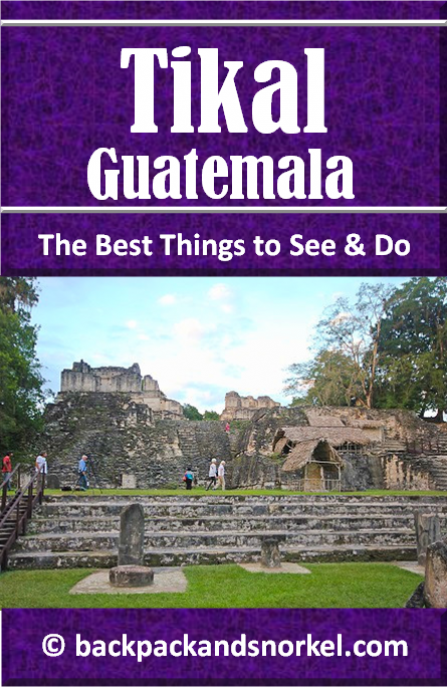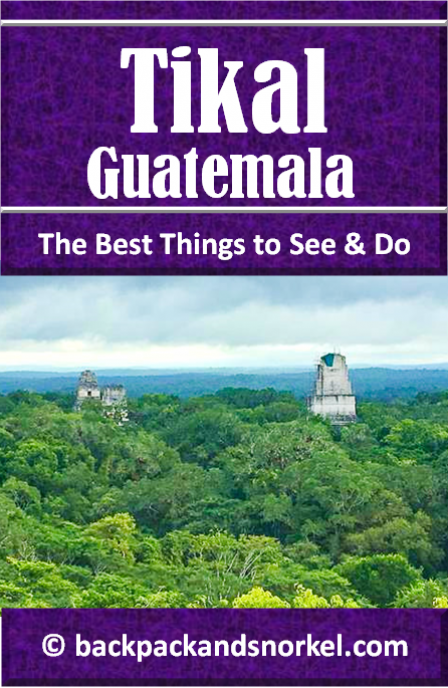MISC STRUCTURES IN TIKAL - Tikal Purple Travel Guide
The major temples are the main attractions of Tikal. When you walk the grounds, you will see lots of smaller structures that have interesting stories. We tell more about these misc. structures and provide background information and photos so you understand what you will see.
Table of contents:
SOUTH ACROPOLIS
Very little is known about the South Acropolis as little has been excavated so far.

Source: Avalon Travel
Surveys show that it covers a square base of about 5.4 acres (2.2ha). It is speculated that it may be very ancient, because it is built on 7 platforms with a total height of at least 88ft (24m). On its summit are 4 rectangular palaces surrounding a central pyramidal temple.
EAST ACROPOLIS
Very little is known about the East Acropolis. It is contiguous to Group F and it almost never shows up on maps. It is believed that there were steam baths here and one of Tikal’s ball-courts.
Back to the Self-Guided Walking Tour of Tikal
EAST PLAZA
East Plaza was Tikal’s market place was located in the east plaza, a large quadrangle with several small buildings located on the side.

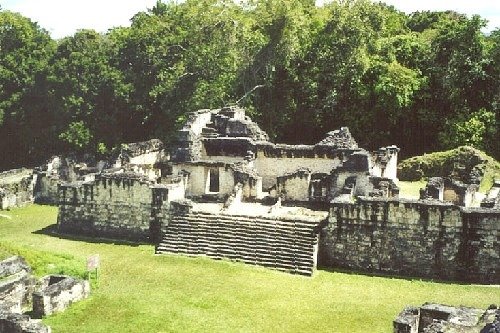
Originally, two twin pyramid complexes were built here at around 600AD. At around 700AD, a ball court and a shrine (Structure 5D-43) were added.
STRUCTURE 5D-43
Structure 5D-43 is an unusual temple which was built over an earlier twin pyramid complex probably during the reign of Nuun Ujol Chaak or son Jasaw Chan K'awiil I in the later part of the 7th century.
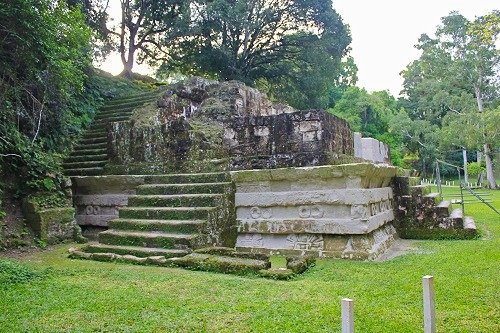
It has four doorways, but only three stairways. There is no fourth stairway (to the south) as the temple abuts the East Plaza Ballcourt and there was simply no space. The roof of the structure displayed a monstrous face, maybe a jaguar, with another head emerging from its mouth. The emerging head has a bifurcated tongue and is believed to be that of a snake.
The proximity of the shrine and the ball court, warfare images displayed on the building, and the time when the shrine was built could indicate that the shrine was built for ritual sacrifices of Calakmul prisoners.
STRUCTURE 6C-16 (GROUP OF THE MASKS)
Tikal Group 6C-16 is located 1,000 ft (300m) south of Mundo Perdido. No access roads for visitors lead to this location.

It was a residential complex for Tikal’s elites and excavations showed that there were 184 structures which were built in 23 construction phases. Elaborate stucco masks, ballplayer murals, relief sculptures and buildings with Teotihuacan characteristics were found here.
Back to the Self-Guided Walking Tour of Tikal
BALLCOURTS
Five ball courts were discovered in Tikal.
The ball game was a sacred ritual that originated more than 2,000 years ago and was closely related to the Underworld and to the myth of the Twin Brothers Hunahpu and Ixbalanque.
The Popol Vuh ("Council Book" or "Council Papers"), which is the most important sacred book of the Maya of the Guatemalan Highlands, describes the history of the K'iche' (Maya) people and their rulers and mentions the important position of the Maya ballgame.
It tells the story of the twin brothers Hun Hunaphu and Xbalanque who played ball and the noise of the game angered Vucub Came, the master of the underworld. A fight erupted and resulted in the formation of the game. After the game, one of the brothers was decapitated. His head was used as the game ball while the blood of his body escaped in the form of snakes.
The rules seem to have changed over the centuries. What has not changed is that two teams played against each other using a rubber ball. The game was played for 2 weeks and the number of players varied between 2 and 6 players per team. Some depictions show an additional person, who may have been a referee.
The ball was not allowed to touch the ground. It could only be moved or passed to other players in the same team by kicking it with the hip, arms or legs, but not with the hands. There were two ways to score. The first one was to score points, like in tennis, by returning the ball to the other team.
Ways to score were:
- When the ball hit any part of the body other than the buttocks and upper leg
- When the ball landed in or flew out over one of the end zones
- When the ball died on the court without being passed across the center line into the opponent’s territory
The second and much more difficult way to score was to kick/throw the ball through a ring that was mounted to the opposing walls in the court. Unlike today’s basketball ring, the ring was turned by 90 degrees. In some variants, the scoring team got a point and in other variants the scoring team automatically won, regardless of the score.
The opposing team (defense) tried to make the ball carrying team lose control of the ball so that it touched the ground.
Players were dressed in leather protective gear that shielded against the impact of the 7-9lb (3-4kg) ball, which had about the size of a volley ball, mainly at the hips and the chest, but sometimes also at the knees and arms and rarely also at the feet. It appears that some players wore head dresses (like deer heads, and feathers).
The Maya showed devotion to their gods by playing the game and by sacrificing people. It is not known who was sacrificed and how often that happened, but it is proven that ballgames and sacrifices by decapitation or disembowelment happened together.
Some archeologists believe that captured kings and upper class people were sacrificed, others believe the losing teams were sacrificed and others believe that captives who would have been executed anyway were sacrificed at those events.
Central Plaza
The oldest and smallest ballcourt of Tikal is located south of Temple I. It has a typical open design with no terminal walls or enclosure.
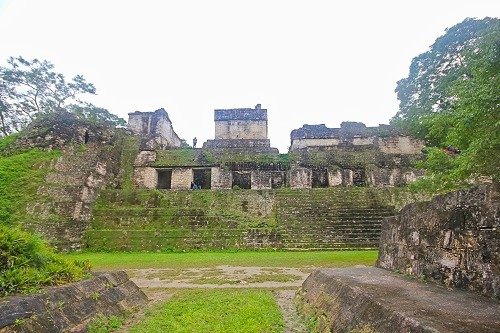
Structure 6C-16
The Group of the Masks (Structure 6C-16) has many murals showing ballplayers depicted and it appears that this must have been a center of ball games. It appears that a slightly modified ball game was played here which was against polychrome-painted steps and not sloped walls.
Plaza of the Seven Temples
The Plaza of the Seven Temples has a triple ball court.
PALACE DE LAS VENTANAS (WINDOWS PALACE) OR BAT PALACE (PALACIO DE LOS MURCIÉLOGOS)
This U-shaped structure was originally two stories high, but the top story collapsed. The lower floor has a double row of rooms and many openings which are likely windows and therefore the name Windows Palace. The upper floor has a single row of rooms. It is also called Bat Palace, because of the bats that live here.
There are speculations that the courtyard that is enclosed by the palace may have been used for ball games.
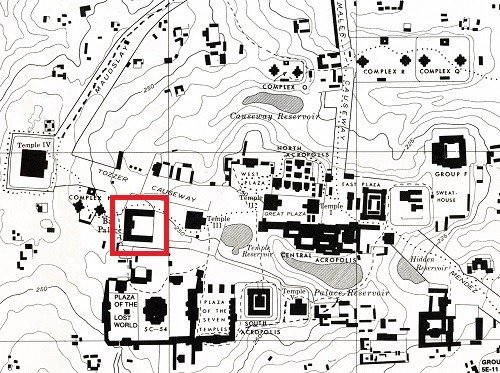
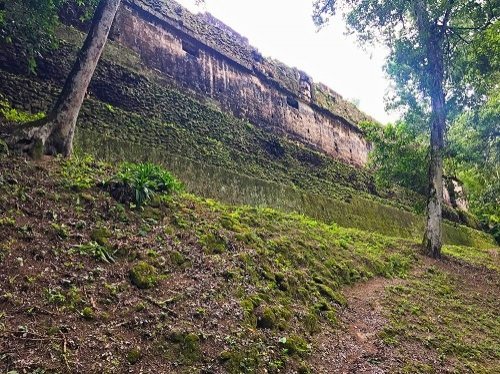
Back to the Self-Guided Walking Tour of Tikal
What do you want to explore now?
Other popular Purple Travel Guides you may be interested in:
Like this Backpack and Snorkel Purple Travel Guide? Pin these for later:

